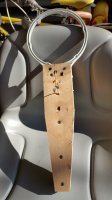Before answering mr Byte me, let me tell the good new:
Last night the WS has recycled and no resin is spilled out. As indicated by a member, we should notify to the forum about the result of the suggestions. Let me add also that once a member has spend the time to write it down for you and you read it, you should say thanks. Again, thanks for offering lot of suggestions.
Now back to the pump efficiency.
Efficiency is defined as the output received divided by the input supplied. With electrical heat from a resistance, assume you get 990 watt output of heat while you spend 1000w of power, the efficiency is 990/1000= 99%. For conventional electric motor from 1-4hp, it is ~80%. For the new type of motor driven by the inverter technology (in the split system or new refrigerator) with square wave instead of the sine wave, the efficiency is much higher.
I know a little bit more about electricity, motor and not expert in flow dynamic nor in pump.
If a csv is set at 50 psi, the water pressure before the cvs and outside of the pump is high once you restrict its flow. With the pump impeller rotating without being able to push out the water, the rpm could be slower and making the pump and motor hotter. Since the pump electric motor is supposed to run at a certain rpm, any extra torque slowing it down more than the allowed specs will increase the current consumption, increase the heat and decrease its efficiency a lot. There are plenty of curves, diagrams for pump specs that I've studied before I installed my pump in 1998 besides checking my neighbors' pump performances. A 1 hp would takes 4 or 5 times to fill a tank compared with a 2hp, so the efficiency is not linear.
Here are the numbers for my 2hp at the bottom of the lake:
Case 1: Water pumped into the cistern.
gpm= 40, Head THD= 120'.
GPM x TDH / 3960 = 40*120/3960=1.21 WHP (Water Horse Power)
Case 2: Water pumped into the storage tank with pump switch set at 40-60. Use the average 50 psi
gpm=10, Head THD=120'.
GPM x TDH / 3960 = 10*120/3960=0.30 WHP (Water Horse Power)
Extracting the heat out of the pump motor is important too. My neighbor installs his 1st pump laying at the bottom of the lake without any casing. The motor is on/off often because the surrounding water although at 60 degree could not cool it down. The pump has to sit inside a pvc casing so the intake water goes around the motor to cool it before being drawn into the pump. Well amateurs like us has to learn the hard way. Hiring an experienced plumber working on pump is very expensive.

